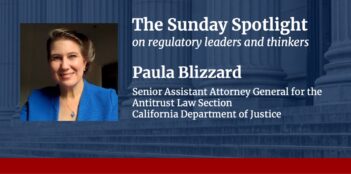
Scholar argues that antitrust regulators should more closely scrutinize bank mergers.
One hundred years ago, over 30,000 banks operated across the country. Today, because of bank mergers, fewer than 5,000 remain.
In a recent article, Jeremy C. Kress of the University of Michigan Law School argues that antitrust regulators should more frequently block bank mergers. The problem, as he sees it, stems from how antitrust regulators have applied what is known as the consumer welfare standard. Kress calls for regulators to strengthen their analytical tools and to use a more expansive standard that would protect the public from so-called non-price harms from bank mergers.
Since the 1970s, antitrust regulators and the courts have followed what is known as the consumer welfare standard. The standard originated from the market-friendly Chicago school of economics, which introduced a narrower approach to analyzing mergers under antitrust law. Under the standard, courts and agencies now consider corporate mergers anticompetitive only when the merger could cause a substantial increase in prices.
Kress argues that the consumer welfare standard has “neutered bank antitrust enforcement” and failed to protect consumers in the process. He points to the U.S. Department of Justice substantially relaxing its merger guidelines in the 1980s as an example of the consumer welfare standard’s pervasive influence.
Regulators now apply one important analytical tool—the Herfindahl-Hirschman Index (HHI)—to identify and screen for proposed mergers that could raise antitrust concerns. The HHI measures market concentration on a point-based scale and is especially sensitive to the size distribution of firms in the market. Under the 2010 Merger Guidelines, any merger that raises a market’s HHI by more than 200 points will likely be challenged by the agencies.
Kress illustrates how, well beyond just price increases, bank consolidation hurts consumers through higher rejection rates for mortgage applications, lower rates paid on customer savings accounts, and substantial increases in personal loan interest rates. One study revealed that a 100-point increase in a market’s HHI is “associated with a twelve- to fourteen-basis point increase in personal loan rates.”
Importantly, Kress finds that bank mergers disproportionately harm low-and-moderate-income and minority communities, which only “exacerbates disparities in access to affordable financial services.” Kress points to a study that found that predatory financial services, such as pay-day loan companies, proliferated in minority communities following major bank mergers.
To revive bank antitrust enforcement, Kress calls on regulators to strengthen the analytical tools they use to identify potentially anticompetitive mergers. Kress argues that the HHI threshold for bank mergers should be lowered to ensure that a greater number of anticompetitive mergers are closely scrutinized by regulators. Kress contends that doing so would underpin banks’ obligation to show how a proposed merger’s benefits to the public would outweigh any anticompetitive effects. And Kress emphasizes that, because banks occupy a special role in the economy as facilitators of credit and the money supply, regulators should be applying higher standards of review to their practices.
Traditional HHI analysis also fails to consider the mix of large and small banks in the market, according to Kress. He stresses that small local banks serve entirely different customers and specialize in different products than global megabanks. Kress calls on the Justice Department and agencies to consider the mix of “megabanks, regional banks, and community banks” in addition to the HHI.
Kress also worries about the other economic harms that can result from bank mergers that pass muster under the consumer welfare standard, with its narrow focus on consumer efficiencies. Two non-price harms that Kress identifies include diminished product quality and “too-big-to-fail” subsidies.
Local branches that offer in-person service form an integral part of banking product quality, according to Kress. He points to one study showing that the likelihood of a branch closure increases by 27 percent in the aftermath of a bank merger in any given area.
Customers with low or moderate incomes rely on in-person banking the most and branch closures deprive them of necessary financial services, Kress notes. He advocates that antitrust agencies require merging banks to disclose in advance any planned branch closures prior to approval of their merger.
Another non-price harm Kress identifies stems from the “too-big-to-fail” subsidies that benefit large banks and hinder competition for services from smaller, community banks. Ensuring the survival of smaller community banks–who disproportionately serve low-income and minority communities–remains crucial to equitable access to banking services, Kress emphasizes.
In the aftermath of the 2008 bailouts, Kress and other scholars argue that “certain large banks benefit from a perception that the government would bail them out if they were to experience economic distress”—and thus they borrow money at lower, more favorable rates. Kress calls on regulators to measure whether a bank would gain or expand a “too-big-to-fail” subsidy following a merger.
Overall, Kress emphasizes that a revival of more demanding bank antitrust enforcement is essential to a robust and competitive economy.



